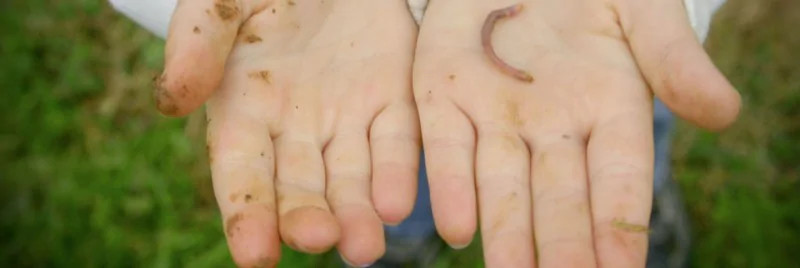Image by Gainesvegas
Have you and your kids ever gone worm-charming, or headed outside to look for worms after it's rained? Has your little one ever dangled a worm in front of your face or run after you with one at the park?
Even if you're not the most enthusiastic worm-lover, you'll find this easy eco-friendly activity great for teaching your kids all about recycling and taking care of the environment.
All about worms for kids - what's the big idea?
They wriggle, they squirm, they look a little bit slimy – so why should you encourage your children to get hands on with worms? Well, the humble earthworm is a good example of how something small and seemingly insignificant can actually have a big role to play when it comes to protecting our natural environment and helping it thrive.
When worms tunnel through the earth they help plant roots get greater access to water and air and the nutrient-rich waste that they leave behind also helps the plants to grow. Worms are fantastic natural recyclers that can convert food scraps from the kitchen – otherwise destined for the landfill site – into compost for the garden or vegetable patch.
How to make your own worm farm
What better way to learn about earthworms than by observing them at work in your very own worm farm? You can find everything you'll need to make worm farms for kids at home in your cupboards or in your garden. Worm farms can be any size you want as long as the wrigglers have a healthy amount of space to move around.
To make your own worm farm, you will need the following:
A container
This should be transparent if you want to observe the worms moving around. Glass jars, plastic drinks bottles, or small aquariums work well, but these must always have air holes in the top, drainage holes in the bottom, and a cover to prevent escapees, excess rain damage, and the attention of hungry birds!
Bedding
Garden soil layered with sand makes for a great visual combination that will intrigue curious minds. Your kids will love watching the worms mix everything up as they burrow; but shredded newspaper works just as well. Fill the container about two thirds of the way full and make sure the bedding is moist – neither wet nor too dry.
Worms
The most fun part of this activity will probably be the worms, for kids. Enticing them out of the earth is a task in itself, but if it's taking too long for you, or you're having no luck, you can actually order composting worms on the Internet to arrive at your home by post or simply buy some from your local garden centre.
Composting worms aren't your usual garden variety – they're shorter and red and they tend to stay close to the surface of the earth. Regular earthworms burrow deeper to avoid conditions they don't like.
Food scraps
If you want your worms to survive and keep pests like maggots from breeding in your worm farm, make sure you avoid meat scraps or dairy foods. Worms can also react badly to salty, spiced, and citrus foods. Cut the food up into small pieces and only add more once the previous batch has been eaten. This can take more than one day.
Darkness
Worms are generally not fans of sunlight as it tends to dry out the skin through which they breathe. To be kind to your worms make sure small containers are kept in cupboards, or covered with black paper to keep the light out.
Stain removal tips
Making a worm farm from scratch can be a messy process and that might mean muddy clothes. Be sure to protect surfaces and clothes before you start this activity and keep Persil Bio Liquid Detergent to hand in case any stains happen in the process – our article on how to remove mud and grass stains from clothes may be particularly useful! Or check out Cleanipedia's article on easy stain removal hacks.
Interesting worm facts for kids TERESTING WORM FACTS FOR KIDS
While you're making your worm farm, why not share these facts with your kids:
There are around 34,000 different types of worm in the world.
Worms do not have lungs – they breathe through their skin.
Worms eat at least one third of their own body weight in a day.
Worm poos are actually called 'casts' and are often found bagged up in gardening stores for use as fertilizer.
Another word for worm farming is.
For even more fun facts, check out this article from the National Geographic or this guide from the BBC.


